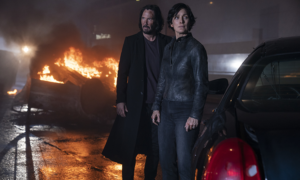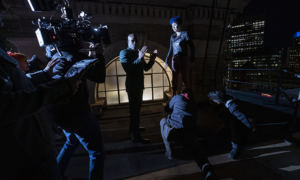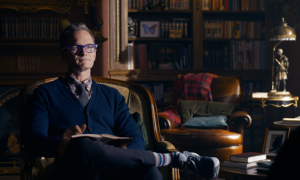Neo (Keanu Reeves) and Trinity (Carrie-Anne Moss) are back with The Matrix Resurrections. Not that they know it when the movie first begins – with Trinity now a housewife known as ‘Tiffany’ and Neo back as Thomas Anderson – a videogame designer whose biggest hit ‘The Matrix’ seems to be a lot more personal than something he just created in his head…
Directed by Lana Wachowski (from a screenplay by Wachowski, David Mitchell and Aleksander Hemon), The Matrix Resurrections is the fourth entry of The Matrix franchise and is now available on video on demand.
To celebrate the release, we spoke to the movie’s editor Joseph ‘Jett’ Sally about how a brunch turned into him working on the latest Matrix movie. Warning: there are minor spoilers in this interview…
You’ve worked with Lana Wachowski before on Speed Racer and Sense8, but how did that initial conversation go for you to work on The Matrix Resurrections?
It was an ongoing possibility toward the end of Sense8 when she visited LA but the real kicker was about three years ago. I went to San Francisco to visit some friends which included visiting Lana, and after brunch, she invited me upstairs to read the first third of [The Matrix] Resurrections and asked if I would be excited to work on it! Which blew my mind because the opening is so fun…
What is the first job you do as an editor?
I usually read the script a couple of times to get an idea in my mind of what the film will look and sound like.
[For this film] I was in San Francisco for the table read. So I got to meet all the actors and start putting faces to the characters. The table read was a bit surreal, because in this big square, everyone was sitting around and I was directly opposite Lana and Carrie-Anne [Moss – Trinity] and Neo [Keanu Reeves]. That was surreal. That took a few minutes to chill. But it was fun because it was also a bit of a reunion for a bunch of them. It was just a fun experience.
Then I was sent off to Berlin while those guys started shooting. But I start cutting right away so I could keep up with the camera. That’s kind of how it works. Also I have conversations with Lana as we go. I didn’t have them around for the first month or so because they were in San Francisco and I was in Berlin. But there’s always really good communication between us.
What were those initial conversations with Lana like? Did the two of you outline what you wanted for the film ahead of shooting?
No, she doesn’t quite do that, which is a good thing. Because there is discovery and things that I feel on the way that I interpret, and things change from the page to what’s filmed. Readings change. Things just change and then she has an opportunity to be surprised by my discovery and things that she wouldn’t necessarily have thought of.

What is it like working on an established franchise? Does it make your job easier or harder?
It’s a strange thing because fans do have a tendency to take ownership of things but they also want to be surprised by new things. So you always have to be mindful of respecting the franchise, respecting the fans but also, thanks to our writers, there are always new ways of surprising them. But yeah, it is tough because you want to be respectful, but you also want to take them somewhere they haven’t been, both in the script and in the cutting style.
The Matrix Resurrections has a lot of established characters – how does that affect the editing?
It does affect us. One of the biggest things came up in the very opening scene, which is very reminiscent of the original scene [in The Matrix]. Echo (Ellen Hollman), who is the game version, the younger version of Trinity, did that kick where she rises up in frame and we do a 360 around her, and then she kicks butt! It was beautiful and it worked really well, but Lana wanted to respect Carrie-Anne and Trinity. That was her thing. So we took it out.
It was tough to let go of it. But we took it out and Echo’s kick and run along the wall was great for her too. So it worked out in the end. That was one example.
[Also, with Morpheus], we wanted to try hard not to repeat everything that the original Morpheus did and give the new Morpheus (Yahya Abdul-Mateen II) enough of the same but create his own his own character, which was quite humorous and very supportive too.

The Matrix Resurrections has a lot of timelines, realities and worlds. How do you keep track of all that? We’re imagining a giant corkboard with red strings linking everything up…
Did you come visit our cutting rooms? That is almost exactly what it looked like [haha]. Our PA had a printout of all the characters on a wall and she had strings connecting everyone to see how they were connected. It does help to have a visual display of who’s connected to who. So that was helpful!
Most times, films are shot out of context. So you have to have that in your head that you’re building this puzzle. Even when you’re building a regular puzzle, most people start with the outside frame and you work your way in. It’s a simplified version, but once I start building you get a sense of the characters and if you want to hold back on some things. Like when Trinity and Thomas meet for the first time, we wanted to hold back on any real emotional cues because you have to build. But it’s very sweet when they first meet, it was just enough.
What is the biggest challenge you face as an editor?
Pacing is always a big challenge. You have to know what to let go of, and when. Then also, sometimes you have to know when to put things back. Because things that you do early on, without realising it, affect stuff in the second or third act, and you don’t even realise it until you get there and then then you’re like ‘ah, I needed that moment’ or ‘that was too much there. I need to scale back on them’.
Was there anything you took out that you then had to put back in?
In the brainstorm sequence, we originally we took out too much of Trinity. We needed a thread of her so you had a sense of him pining for her throughout this whole brainstorming thing. That in itself was a big challenge because we worked on it almost daily.
Also with The Analyst, we wanted to make sure that we didn’t give away too much too soon. In The Analyst’s room when he’s with Thomas we had to pull some things out because either a gesture or a look gave away too much!

What’s your favourite element of your job?
I love that the whole process changes. Because I love production. Sometimes it can be overwhelming because on a show like this, there’s so much footage but I love the opportunity for me to sit with our briefing and build this cut. But then I love working with Lana as a director because then you start moulding things, it’s their opportunity to change line readings and to change performances around.
Then we get to the mix… all along I always think about getting digital effects like early Christmas presents because for the longest time I’m working with pre-vis or I have layers of comps that I’ve been building and then all of a sudden you see this nice version of a shot with CG characters. It’s great. So I like all parts of it and I’m lucky that they change all throughout.
What’s your favourite sequence in The Matrix Resurrections?
There are quite a few. The brainstorm sequence because there’s so much in it and this world that we’re in is so meta right now, and that is brilliant.
I also like Tiffany’s workshop where The Analyst puts them into bullet time where he’s still in real time, that dialogue there. It’s also a really smart sequence about people’s wants and desires.
Also of course the rescue! You can’t get away from that! When she yells for him and she’s like: ‘Don’t call me Tiffany, my name is Trinity!’. I like that.
The Matrix Resurrections is available now on Premium Video on Demand.
